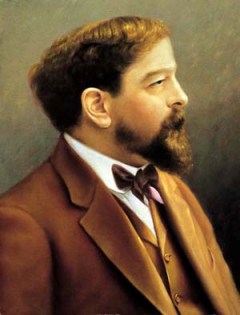Claude Debussy - String Quartet in G minor Op.10
Claude Debussy - String Quartet in G minor Op. 10

1. Anime et tres decide
2. Assez vif et bien rythme
3. Andantino, doucement expressif
4. Tres modere - En animant peu a peu - Tres mouvemente et avec passion
Emerson String Quartet
In 1893, Debussy composed his first important work, the String Quartet in g minor, Op. 10. It was the only work to which he attached an opus number or a key designation and it was the only work Debussy wrote in a conventional form. Outwardly, the quartet assumes the mold of a traditional string quartet comprising four movements: a first movement sonata, a rhythmic scherzo, a slow, lyrical movement and an energetic finale. But within this unremarkable template, the music sounds completely new. Debussy expanded the sound of the string quartet with a variety of novel textures and tonal effects ranging from delicate subtlety to ravishing grandeur. With exotic scales, unconventional chords, progressions and key changes, the music features melodies and harmonies unique for their time. Especially striking is the quartet’s rhythmic vitality, spontaneous agility and poetic subtlety. With swiftly changing tempi, a wealth of dazzling figurations, cross-rhythms and the special shimmering or hovering pulsations typical of his music, Debussy captures a nuanced experience of time. With the benefit of hindsight, it is easy to see many elements of Debussy’s signature style within this early work: the sensuous languor of l’après-midi d’un faune, the kinetic energy of La Mer, the spice and color of his Iberian Images.
Debussy’s quartet is equally fascinating for its cyclic design. César Franck based several of his compositions on a cyclic principle where a signature musical theme recurs in every movement. Earlier, Hector Berlioz featured his idée fixe, a signal leitmotif in every movement of the Symphonie fantastique. Debussy applied the same concept: the opening theme of his quartet recurs in all four movements. But unlike earlier designs where the theme appears, essentially unchanged, within each movement as an isolated, nearly extraneous element, Debussy uses his theme to generate the majority of the quartet’s intrinsic music. Using ingenious transformations of melody, harmony, texture and rhythm, Debussy creates a diversity of music that clearly derives from the initial theme. The first and second movements together contain at least seven variations. The last movement supplies its own new variations as well as a cyclic reprisal of the previous movements in reverse order, leading the quartet right back to the beginning. That such an apparently rigid thematic unity is unobtrusively disguised within a rich variety of music is testament to Debussy’s fertile imagination and his remarkable skill as a composer.
Initial reactions to his quartet ranged from praise, to bewilderment and scorn including such wonderfully revealing sneers as “orgies of modulation” and “rotten with talent”. Debussy shortly set to work on another quartet, but abandoned the project, turning instead to the orchestra, a more potent vehicle for his visionary music. Debussy wrote very little additional chamber music, returning to the genre only at the end of his life to complete three of six planned sonatas. It is amazing to consider the many first rate composers who labored over numerous string quartets, destroyed early works or cautiously approached the genre for the first time as mature artists, while Debussy, merely thirty-one, wrote a single quartet, a brilliant work of stunning originality, now a masterwork secure in the chamber music repertory. --- earsense.org
download: uploaded anonfiles yandex gett 4shared solidfiles mediafire mega filecloudio
Zmieniony (Środa, 23 Październik 2013 16:32)








